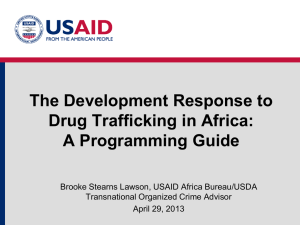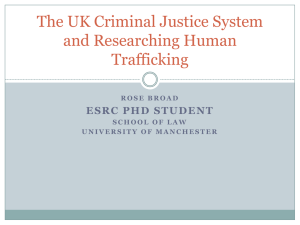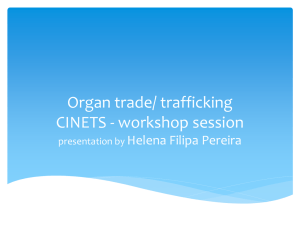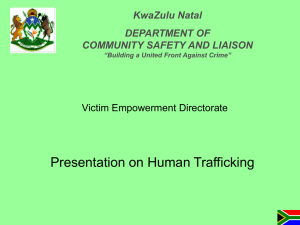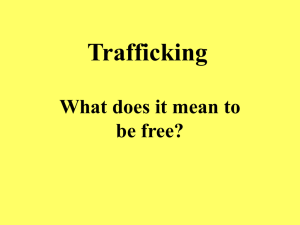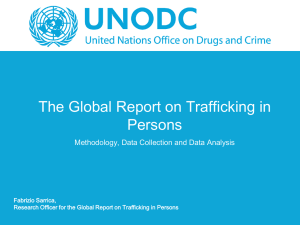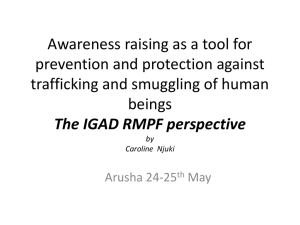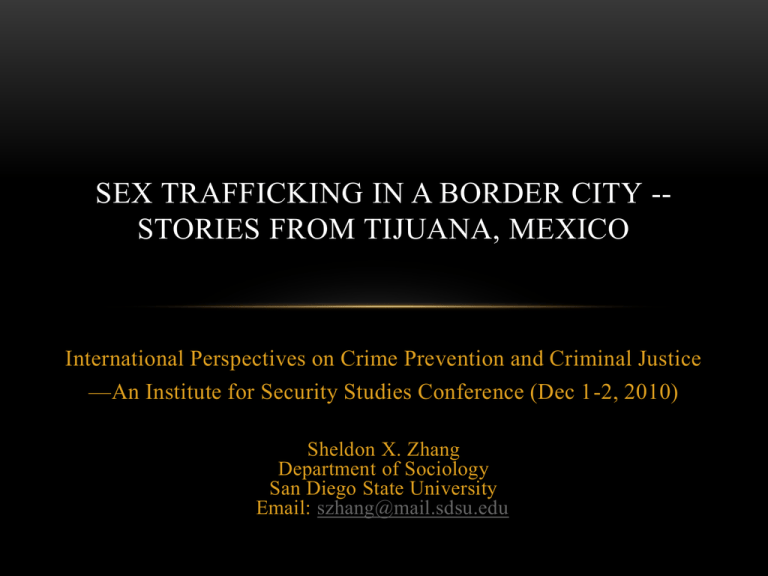
SEX TRAFFICKING IN A BORDER CITY -STORIES FROM TIJUANA, MEXICO
International Perspectives on Crime Prevention and Criminal Justice
—An Institute for Security Studies Conference (Dec 1-2, 2010)
Sheldon X. Zhang
Department of Sociology
San Diego State University
Email: szhang@mail.sdsu.edu
THE SKY IS FALLING
• Massive trafficking activities at global scales.
• Wild estimates issued by governments and NGOs, from tens of
thousands to millions.
• Huge profits—the third-largest criminal industry in the world,
behind drugs and firearms trafficking, with profits in the billions
each year.
• Sex industry is heavily targeted, and western countries as top
destinations.
PROBLEMS IN CURRENT RESEARCH
• Significant conceptual blurring between trafficking and smuggling.
• Overt moral agenda, pointing to sex industry as the prime cause
behind global sex trafficking activities.
• Much has been published, but few with systematic empirical data.
Insistent claims on the large scale of the problem while acknowledging
the difficulties in acquiring empirical data.
• A recent Spanish-literature review suggests this is largely a problem of
the English-language world, with a discourse dominated mostly by
advocacy groups and NGOs.
THE TIJUANA STORY
• Mexico has long been accused by its northern neighbor of being a
transit and source country for a host of problems to the U.S., including
drug trafficking and illegal migration.
• Location and legality would make Tijuana the ideal destination if
trafficking activities indeed are happening.
• Prostitution is legally regulated in Mexico. Tijuana is a major border city,
transit for all sorts of illegal contrabands, a major weekend destination
for Americans, and has a vibrant sex industry.
• There are few reasons for pimps and sex traffickers to bring women into
the U.S. when they can do the same work “legally” on the other side of
the border.
TIJUANA SEX INDUSTRY
• Well established nightclubs such as Adelita and Chicago for catering
to American customers.
• Prostitutes working in Tijuana have long been suspected of being
lured from small towns in the interior of Mexico or other Latin
American countries by traffickers and pimps.
• Local human rights groups and social service agencies claim that few
women working on the street operate as freelancers.
• Estimates on the number of prostitutes in Tijuana vary widely--3,000
to 15,000.
METHODS
• In-depth interviews using semi-structured questionnaires.
• Human subject protection issues
• Recruitment procedures restricted to a public health clinic
• Convenience and snowball sample
• Field observations (Tijuana and interior Mexico)
• N=220
• Support for this study is funded by a grant from the National Institute
of Justice, U.S. Department of Justice
WHERE SEX WORKERS COME FROM
• Most were Mexican nationals; majority came from outside Baja California.
• Most came from states with long histories of north-bound migration--Puebla,
Sinaloa, Veracruz, and Jalisco, Sonora, Michoacán, and Guerrero.
• Most were were between the ages of 18 and 29. The oldest was a 65-yearold woman from Zacatecas.
• Most of these women were on their own (93.2%)—single, divorced,
separated, or widowed.
• More than half of these women (55%) had at least one child.
• The majority (65%) received between a middle and high school education.
• 30 in all (or 13.6 percent), received some college education, which
outnumbered those without any formal education. Sex workers with higher
education tended to work in escort services and commanded higher wages.
MIGRATION TO TIJUANA
• Most women came to Tijuana for economic reasons; a few were staging to
cross into the U.S.; 20 percent claimed to be local residents or were those
who followed their families to the city at a very young age.
• Most of these women followed a familiar migration pattern—through existing
kinship or social networks.
• Their journeys were mostly well-planned ahead with places to stay and
people to greet.
• There were few things remarkable about their journey, although not all were
happy with what was waiting for them in Tijuana.
• However, in a few cases, the journey to Mexico’s northern border was hellish.
Two from El Salvador and three from Guatemala had been raped, robbed, or
beaten. All of these women migrated outside any established familial and
social migration networks.
ENTRY INTO SEX INDUSTRY
• Different personal circumstances, but familiar themes--financial pressure
and survival.
• Most relied on referrals from friends and acquaintances. A few ventured
into the business on their own.
• All sex venues constantly seek fresh faces, finding a job was not difficult.
• The vast majority (74 percent) took the initiative to seek jobs in the sex
industry because of the earning potential given their circumstances.
• A small number, 26 of the women (or 11.8 percent), had been either forced
or at least pressured into prostitution at some point. Most perpetrators were
pimps, husbands/boyfriends, and male relatives.
EXPERIENCE IN SEX INDUSTRY
• Wide range of experiences, often dependent on venues and circumstances.
• Average length of 40 months vs. the median of 24 months—wide range of
experience, with the longest for 10 years on the street, after 20 years in strip
bars.
• The majority of the women worked eight hours a day and six days a week.
PRICE OF SERVICE
• In general, the women were well aware of their own earning potential and
what type of sex services or acts would command higher prices, and would
not hesitate to demand different prices for different sex services.
• Pricing for sex services varied tremendously depending on many factors,
such as business locations and clientele (i.e., escort services, strip bars,
massage parlors, and streets), age, and appearance.
• Prices also varied depending on what type of sex acts the client desired, or
whether condom was required. Such variations represented different pricing
criteria and opportunities for negotiation.
• The median price per sex act or transaction was $60, with some participants
charging as little as $5.00. On the high end, however, one call girl claimed
to charge a minimum of $2,000 per appointment and sometimes made
$4,000 per night, including tips, from select clients.
OF AGENCY AND RESILIENCY
• Most women demonstrated high degrees of agency and resiliency in surviving
this hazard-filled occupation.
• Their status within the sex industry seemed closely linked to the type of sex
work and work venues (streets, strip clubs, massage parlors, escort services).
• A few cases of coercion and fraud were found, and the victims were all in the
low end of the sex trade serving limited range of clients who came to the
brothels managed by the pimps.
• In most strip bars and particularly in escort services, few women complained
about the lack of control over wages or work schedules.
• Greater control over one’s “work” appeared to engender higher degrees of “job
satisfaction” among these women.
SOCIAL NETWORK
• Instead of viewing themselves as victims, these women self-organized
and assisted one another.
• Friends, male and female, became a common gateway into the sex
trade.
• Most women either already had friends in the sex trade or got to know
them through fortuitous social contacts after arriving in Tijuana, except
for those who were lied to and coerced by their pimps and “husbands.”
A CONTRARIAN MARKET PERSPECTIVE
• Sex industry is ultimately a business.
• Widespread transnational or domestic trafficking activities, as
implied in and targeted by most government agencies and
advocacy organizations, are not only improbable in logistics but
also impractical as business practices.
• Sex trafficking is possible for individual pimps who are:
• adept at seeking out women in vulnerable situations
• controlling their victims through emotional manipulation,
social isolation, and violence.
PROPENSITY OF TRAFFICKING
• The propensity of becoming victimized by sex traffickers increases or
decreases depending on the convergence of four key determinants at the
same time and space
• (1) the strength and on-going maintenance of existing migration channels
determine the level of protection and regulate risks in domestic and
transnational migration, particularly for women;
• (2) the degree of social and informational isolation determines the length of
deception and coercive control;
• (3) the number of unwilling participants proportionally increases logistical
challenges for human traffickers; and
• (4) transactional atmosphere deteriorates in the face of continued moral and
legal campaigns by advocacy groups and government agencies, leading to a
hostile market environment that discourages systematic involvement by
organized crime groups.
WOMEN MIGRATING PATTERN
• Most migrants follow pre-existing networks, established by relatives or
compatriots from the same villages, to particular destinations rather than
simply moving to a country where most money can be made.
• Because of gender-based cultural practices, women from Mexico or Latin
America are less likely to migrate outside the established kinship networks.
• Thus restricting the pool of potential victims vulnerable to sex traffickers.
• However, sex trafficking is likely to happen when the potential traffickers are
part of the kinship network or when migrant women do not have the
protection of an existing network.
• Therefore one would argue unless a large number of migrant travel under
these two conditions, the number of potential victims is likely to be limited.
AN IMPROBABLE FEAT FOR PROTRACTED AND
MASSIVE DECEPTION AND COERCION
• Continued deception and physical coercion, the two key elements in
defining human trafficking, are difficult to sustain over protracted
periods of time or over long distances.
• This is a particularly difficult feat when a large number of people
(women in this case) are involved.
• Most sex industry concentrates in urban areas, permeated with
modern telecommunication and mass media.
• It was rare to find any sex workers in my study who did not have a
mobile phone.
• Customers (johns) are there most likely to have a good time and least
likely to look out for the interests of any specific brothels.
CONTROL REQUIRES ISOLATION
• Deceptive schemes or physical force require ongoing isolation or a highly
controlled environment in order to be effective.
• Once victims start interacting with customers and mingling with other
prostitutes, risk exposure on the part of the sex trafficker increases.
• Information about pricing and work conditions is exchanged, which
quickly improves a prostitute’s market knowledge and occupational
savvy.
• Continued coercion may go on through individualized and personalized
manipulations (such as a fake romantic relationship or threat of exposure
to a woman’s family).
• Most pimps are eager to show off and display their women to attract
clients.
LOGISTICAL CHALLENGES IN TRAFFICKING AND
MANAGING HUMAN BEINGS
• Transporting and managing unwilling or reluctant human beings in any
significant number are inherently difficult.
• Most cases reported in the news, government reports, and in this
study, suggest that sex trafficking involved mostly individual
entrepreneurs who managed small groups of women, perhaps one to
three women at any time.
• Their manipulative techniques also relied heavily on individual and
personal persuasion, at least initially. Such trafficking schemes are
highly individualized and seem only workable in small and limited
contexts and almost always require the physical presence of the
trafficker.
HOSTILE MARKET ENVIRONMENT
• Thanks to continued anti-trafficking campaigns by advocacy
groups and government agencies, prostitution remains illegal in
many Western countries.
• Any systematic involvement in trafficking activities invites
unwanted attention from the community and law enforcement
agencies.
• It is unlikely that any established organized crime groups would
want to get involved in the business in such a hostile market
condition. The overall market condition will continue to
discourage the participation of any systematic involvement of
organized crime.
Figure 1. The Trafficking Propensity Square



